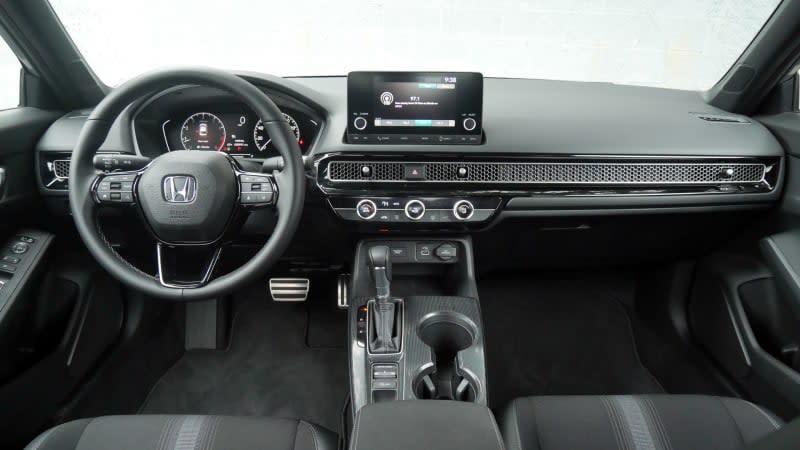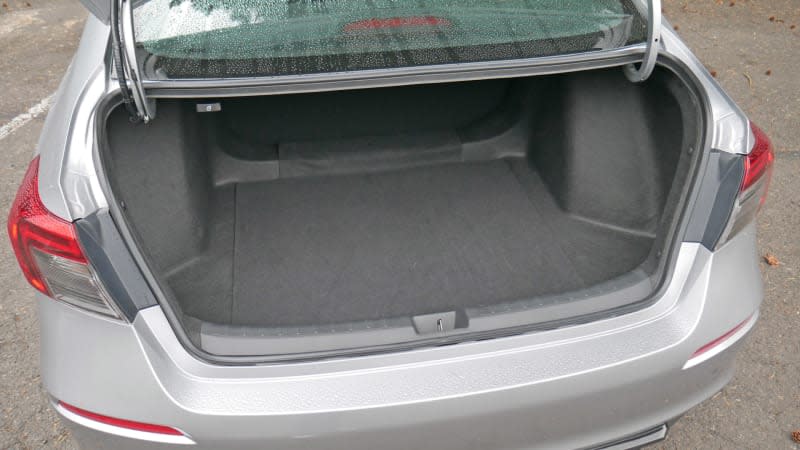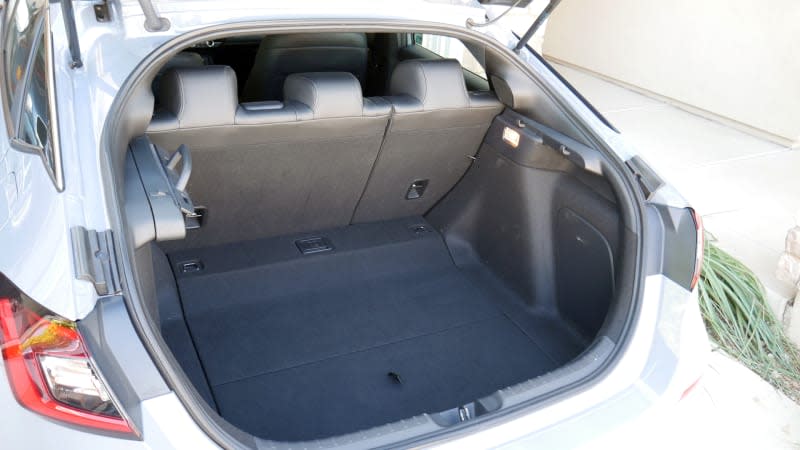2024 Honda Civic Review: Sedan or hatchback, LX trim to Type R, it's the best compact car

Pros: Cool and well-made interior; very spacious; powerful and efficient turbo engine; well-balanced driving dynamics; instant-classic Type R
Cons: Pricey starting point; no hybrid (yet); rudimentary standard touchscreen; no auto option for Si
Let’s cut to the chase: The 2024 Honda Civic lineup represents our top compact car choice, and it’s really not a close race. The sedan and hatchback are so well-rounded and well-executed, you could easily have more money to spend on a car and still wind up with a Civic. It has the passenger and cargo space to be a reasonable alternative to a midsize sedan or compact SUV. The range-topping Touring rivals entry-level luxury cars (including the mechanically related Acura Integra) for interior ambiance, equipment and quality. The sport-tuned Civic Si and instant-classic Civic Type R can do double duty as weekend sports cars and daily drivers. There’s even a Civic Hybrid likely to be introduced later in the year for those seeking max fuel economy.
It's also worth pointing out that the 2024 Civic sedan and hatchback look great and boast an ultra-cool interior. In particular, the full-width honeycomb air vents still look special after three years and inspiring copy-cat looks throughout the Honda lineup. We also like that last year’s reborn Type R is a little less boy-racery in appearance despite keeping the wing and red interior (though the Si’s own red bits and pieces can come off as a bit tacky).
So, from an objective and subjective perspective, the 2024 Civic lineup delivers. One of our complaints last year, a high price of entry, has been mitigated by the return of the base LX but still remains higher than those of rivals. Those with higher budgets, however, should find the Civic stands skyscraper-tall against a dwindling number of competitors including the Mazda3, Hyundai Elantra, Kia Forte, Nissan Sentra and Toyota Corolla, plus Volkswagen’s Jetta, GTI and Golf R.
Interior & Technology | Passenger & Cargo Space | Performance & Fuel Economy
What it's like to drive | Pricing & Trim Levels | Crash Ratings & Safety Features
What's new for 2024?
The base LX trim level reappears after taking last year off. This effectively lowers the Civic’s base price.

What are the Civic interior and in-car technology like?
In a segment filled with surprisingly impressive interiors, the 2024 Civic interior delivers even in the base Sport trim level with cloth seats and the base infotainment system (pictured in the large picture above). This is still an economy car, so there's plenty of hard plastic about (center console, door sills), but what you see and touch most come together in a tasteful, modern design that looks (and feels) like it belongs in a much pricier car. There's more than a whiff of Audi right down to the way the buttons and knobs click satisfyingly. We also have to call out the dash-width air vents, with their honeycomb openings, metallic finish and clever knob controllers (they're outlined in red in the Civic Si). They're so great, Audi probably wishes it had come up with them first.
There are two infotainment systems available. The 7-inch base touchscreen (below left) is awfully simple, and although commendably easy to figure out, rival systems are superior. The 9-inch unit (below right) found in the Tourings, Si and Type R that gains increased functionality and is far more competitive. Apple CarPlay and Android Auto are standard (wireless with the 9-inch unit), and with CarPlay at least, we like that Honda doesn't lock out touchscreen controls for the Music app (a common annoyance). We also like that Honda has maintained physical menu shortcut buttons.


The LX, Sport and EX have a combination of analog speedometer and 7-inch multi-purpose display, but it all appears to blend together into one unit. It's traditional in design, yet modern in functionality. The Touring and Si get a completely digital, 10.2-inch instrument panel that's similar in basic appearance but provides greater functionality and flashier graphics. The Type R goes even further with unique graphics and shift lights above the IP that evokes race cars.
Finally, one minor note about the Si. As with its many predecessors, the interior features lots of little red accents, including cross stitching, air vent trim and, most notably, the front seat centers. Those in particular look and feel cheap, as if borrowed from padded backpack straps. The rich red hue of the Type R’s carpets and suede-like upholstery are far more successful. In both, however, the back seat is covered in a different fabric that’s black only. It looks and feels like a cost-cutting move rather than an aesthetic choice. One can also question the aesthetic wisdom of making red interiors mandatory even if the outside is painted orange or electric blue.


How big is the Civic sedan and hatchback?
The 2024 Civic is available in sedan and hatchback body styles, although the latter is more like an Audi A7 “Sportback” in body style than an old-school, Civic hatchback. The sedan is 4.9 inches longer, all of which is behind the back wheels, making the trunk a longer, more voluminous space than the Hatchback. That’s right, we found the sedan could hold more luggage than the hatchback despite having less cargo volume on paper: 14.8 versus 24.5. What’s up with this? Basically, all the hatchback’s extra volume is up high where you’re less likely or able to utilize it for actual stuff. It does provide greater versatility, however, as lowering the seats grants a substantially larger space that’s fairly similar to what you’d find in a subcompact SUV. In short, either body style provides an exceptional amount of cargo space for a compact car. You may even find you don’t need to step up to a midsize sedan like the Accord or a small SUV like the HR-V.
That verdict carries over to the back seat as well. In the segment, its 37.4 inches of rear legroom is bettered only by the Hyundai Elantra, and is about 2 inches more than most competitors. For a compact car, it's definitely not compact back there. A 6-foot-3 driver with the seat pushed all the way back still found enough space in the back seat of both body styles to sit comfortably "behind himself." There was also just enough headroom. There’s also plenty of room left up front in the passenger seat after installing a rear-facing child seat in the back. The sedan is pictured below left and the hatchback, in the form of the four-passenger-only Type R, is below right.
One final note: The Si is sedan only while the Type R is hatchback only.




What are the Civic fuel economy and performance specs?
The Civic is available with a choice of four engines, but that’s including those in the Civic Si and Civic Type R.
The Civic Sport is powered by a 2.0-liter inline-four that produces that produces 158 horsepower and 138 pound-feet of torque, which is a typical amount for the segment. Front-wheel drive and a continuously variable transmission (CVT) are standard on every Civic sedan, but the Hatchback Sport gets the option of a sweet-shifting six-speed manual. Fuel economy is 31 miles per gallon city, 40 mpg highway and 35 mpg combined for the LX sedan and 30/37/33 for the Sport sedan. Hatchbacks with the CVT get 1-2 mpg worse, while the manual option drops to 26/36/29.
The EX and Touring sedans, plus the EX-L and Sport Touring hatchbacks, get a 1.5-liter turbocharged inline-four that produces 180 hp and 177 lb-ft of torque. A CVT is standard on all trims with this engine, but the Sport Touring hatchback can be equipped with the six-speed manual. Besides its significantly better performance, this engine is also more efficient: 33/42/36 mpg for the EX and 31/38/34 for the Touring, with the EX-L and Sport Touring hatchbacks roughly 1 mpg lower. The Sport Touring hatchback with the six-speed manual should return 28/37/31.
The Honda Civic Si also has a 1.5-liter turbocharged inline-four, but it produces 200 hp and 192 lb-ft of torque. Front-wheel drive and a six-speed manual are mandatory. It returns excellent fuel economy for a performance car at 27/37/31, but unlike the other Civics, it requires premium fuel.
The Honda Civic Type R has a 2.0-liter turbocharged inline-four that pumps out 315 hp and 310 lb-ft of torque. It too is exclusively paired with front-wheel drive and a six-speed manual transmission. Fuel economy estimates for 2024 were not available at the time of this writing, but it’s unlikely it would differ from last year’s figures of 22/28/24.


What's the Civic like to drive?
Through its 11 generations, the Honda Civic has always been at its best and most competitive when it was responsive and even fun to drive. The 2024 Civic picks up the torch and builds on the significant progress made by the last generation. It's indeed fun to drive, with a lightweight and agile feel that encourages you to seek out winding roads. The steering is precise and consistently weighted, imparting a sense of connection to the driver. Throttle response is also as you'd expect from a driver-focused car, though selecting Sport mode in the Sport or Touring trims really wakes things up with old-school, hair-trigger reactions that any driving enthusiast should appreciate. Importantly, it’s also impressively comfortable, refined and even quiet for a compact car.
The turbo engine remains the one to get given its greater torque, strong acceleration and superior fuel economy. That said, the naturally aspirated base engine is certainly acceptable – it has comparable power to its competitors, but it's smoother and sounds better. It is a Honda after all. The almost-mandatory CVT makes up for some slightly blender-like noises by limiting the yo-yoing between high and low revs associated with this increasingly common transmission. It also simulates gear changes like other CVTs, but does so in a more natural way than what you'll find in a Subaru, for example.
Now, if you don't like the idea of a CVT at all, the Hatchback alone offers a sweet six-speed manual with either engine. The gearbox is flickable, but weighty. Notchy, but not burdensome. Easy to shift for newbies, but oh-so-fun to play with for experts. Seriously, the shifter feel in this approximately $30,000 Honda puts to shame those in much more expensive sports cars. It also does wonders for the turbo engine, making it feel and sound like a much more athletic (and classically Honda) powerplant.



 Yahoo Autos
Yahoo Autos 
